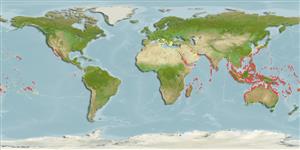Common names from other countries
Environment: milieu / climate zone / depth range / distribution range
Ecologia
; intervalo de profundidade 0 - 20 m (Ref. 349). Tropical
Indo-Pacific and the Mediterranean Sea.
Length at first maturity / Tamanho / Peso / Idade
Maturity: Lm ? range ? - ? cm Max length : 4.0 cm SHL macho/indeterminado; (Ref. 349); common length : 3.5 cm SHL macho/indeterminado; (Ref. 349)
Shell used in shellcraft (Ref. 349). Abundant in rocky reefs, either in exposed or in protected areas and in clear to turbid waters. Most common just below the low tide marks. Members of the family Strombidae are mostly herbivores , browsing on delicate algae, or swallowing sand and detritus to digest the decomposing plant matter (Ref. 349).
Life cycle and mating behavior
Maturidade | Reprodução | Desova | Ovos | Fecundidade | Larvas
Members of the order Neotaenioglossa are mostly gonochoric and broadcast spawners. Life cycle: Embryos develop into planktonic trocophore larvae and later into juvenile veligers before becoming fully grown adults.
Poutiers, J.M. 1998. (Ref. 349)
Categoria na Lista Vermelha da IUCN (Ref. 130435)
Categoria CITES (Ref. 108899)
Not Evaluated
Not Evaluated
Ameaça para o homem
Harmless
Utilização humana
| FishSource |
Ferramentas
Mais informação
Idade/TamanhoCrescimentoComprimento-pesoComprimento-comprimentoMorfologiaLarvasAbundância
Fontes da internet
Estimates based on models
Preferred temperature
(Ref.
115969): 22.7 - 29.2, mean 28.3 (based on 3612 cells).
Vulnerabilidade
Low vulnerability (10 of 100).
